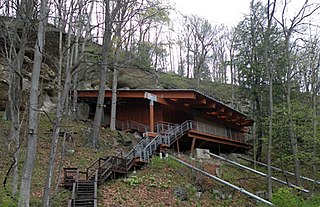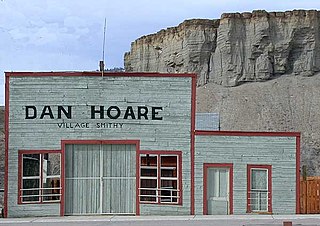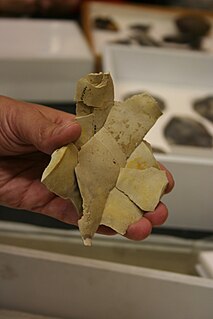
Clovis points are the characteristically-fluted projectile points associated with the New World Clovis culture. They are present in dense concentrations across much of North America; in South America, they are largely restricted to the north of that continent. Clovis points date to the Early Paleoindian period roughly 13,500 to 12,800 calendar years ago. Clovis fluted points are named after the city of Clovis, New Mexico, where examples were first found in 1929 by Ridgely Whiteman.

The Folsom Complex is a name given by archaeologists to a specific Paleo-Indian archaeological culture that occupied much of central North America. The term was first used in 1927 by Jesse Dade Figgins, director of the Colorado Museum of Natural History.
The San Dieguito Complex is an archaeological pattern left by early Holocene inhabitants of Southern California and surrounding portions of the Southwestern United States and northwestern Mexico. Radiocarbon dating places a 10,200 BP date consideration.

Meadowcroft Rockshelter is an archaeological site located near Avella in Jefferson Township, Washington County, Pennsylvania, United States. The site is a rock shelter in a bluff overlooking Cross Creek, and contains evidence that the area may have been continually inhabited for more than 19,000 years. If accurately dated, the site would be the earliest known evidence of human presence and the longest sequence of continuous human occupation in the New World.

The Stanfield-Worley Bluff Shelter, located on private property in Colbert County in northwestern Alabama, United States, is one of the most important prehistoric sites excavated in the state due to the archeological evidence deposited by the Paleo-Indians who once occupied the rock shelter. Lying in Sanderson Cove along a tributary of Cane Creek approximately seven miles (11 km) south of the Tennessee Valley, the shelter and the high bluffs of the surrounding valley provided a well-protected environment for the Native American occupants.
Clary Ranch, formerly a private cattle ranch, is a site of multiple archaeological digs, many of which produced significant artifacts and remains.

The Thunderbird Archaeological District, near Limeton, Virginia, is archaeological district described as consisting of "three sites--Thunderbird Site, the Fifty Site, and the Fifty Bog--which provide a stratified cultural sequence spanning Paleo-Indian cultures through the end of Early Archaic times with scattered evidence of later occupation."
J&J Hunt Site (8JE740) is an inundated prehistoric archaeological site located 6 km off the coast of northwestern Florida. The site which was discovered in 1989 is located in 3.7 to 4.6 m of salt water in the Gulf of Mexico along the PaleoAucilla River. In prehistory the site had at least two different occupations: a Late Paleoindian-Early Archaic and Middle Archaic. The J&J Hunt site was a major focus of the PaleoAucilla Prehistory Project conducted by Dr. Michael K. Faught.

Cueva Fell is a natural cave and archaeological site in southern Patagonia. Cueva Fell is in proximity to the Pali Aike Crater, another significant archaeological site. Cueva Fell combined with the nearby Pali Aike site have been submitted to UNESCO as a possible World Heritage Site.
St. Mary Reservoir is a reservoir in southwestern Alberta, Canada. It was created for irrigation purposes by the damming of the St. Mary River, which was completed in 1951. The Kainai Nation's Blood 148 Indian reserve borders its northwest side. There are camping and picnic areas at the reservoir, and it is a popular site for power boating, water skiing, windsurfing, swimming and fishing.

Golondrina points are lanceolate spear or dart projectile points, of medium size, dated to the transitional Paleo-Indian Period, between 9000–7000 BP. Golondrina points were attached on split-stem hafts and may have served to bring down medium-sized animals such as deer, as well as functioning as butchering knives. Distribution is widespread throughout most of Texas, and points have also been discovered in Arkansas and Mexico. The concentration of Golondrina specimens is highest across the South Texas Plains, where the point is the most prevalent of Paleo-Indian types and defines a distinctive cultural pattern for the region. The Golondrina point is so named for its flared basal corners ("ears"), which resemble a swallow's split tail. Classification of Golondrina can be difficult because of its similarity to other types, particularly the Plainview point, to which it was originally thought to be related.
The Paleoindian Database of the Americas (PIDBA), is a website dedicated to the compilation of projectile point and other relevant data pertaining to Paleoindian site assemblages across the Americas. As of April 2011, the PIDBA database contains information pertaining to locational data (n=29,393), attribute data (n=15,254), and image data on Paleoindian projectile points and other tools in North America and also includes bibliographic references, radiocarbon dates, and maps created making use of database and GIS data. The PIDBA site provides a database that is useful in studying stylistic and morphological variability, lithic raw material usage and procurement strategies, geographic distributions of technology, and land use strategies during the Paleoindian period, which took place prior to ca. 11,450 cal year BP. The PIDBA database also serves a function as an intermediary between academic and advocational archaeologists in the collection and integration of primary projectile point data. Overall, the PIDBA project aims to compile data from multiple sources into a comprehensive database, while simultaneously seeking out and including new data. The PIDBA website contains a large amount of primary data collected and donated by researchers and advocational archaeologists from all over the Americas ranging from metric measurements to the type of chert any particular piece is made from. It is the voluntary contributions of primary data from these researchers that makes PIDBA possible. While it is understandable that researchers would like to fully examine and publish on their data, the site’s philosophy is that it is important to disseminate information freely, so that other researchers can work with it. This allows researchers to make new discoveries that they perhaps would not be possible otherwise.

The Jones-Miller Bison Kill Site, located in northeast Colorado, was a Paleo-Indian site where Bison antiquus were killed using a game drive system and butchered. Hell Gap complex bones and tools artifacts at the site are carbon dated from about ca. 8000-8050 BC.

The following outline is provided as an overview of and topical guide to the prehistoric people of Colorado, which covers the period of when Native Americans lived in Colorado prior to contact with the Dominguez-Escalante Expedition in 1776. People's lifestyles included nomadic hunter-gatherering, semi-permanent village dwelling, and residing in pueblos.

Dent Site is a Clovis culture site located in Weld County, Colorado, near Milliken, Colorado. It provided evidence that man and mammoth co-existed in the Americas.
Hell Gap complex is a Plano culture from 10,060 to 9,600 before present. It is named after the Hell Gap archaeological site, in Goshen County, Wyoming.

Hell Gap is a deeply stratified archaeological site located in the Great Plains of eastern Wyoming, approximately thirteen miles north of Guernsey, where an abundant amount of Paleoindian and Archaic artifacts have been found and excavated since 1959. This site has had an important impact on North American archaeology because of the large quantity and breadth of prehistoric Paleoindian and Archaic period artifacts and cultures it encompasses. It was designated a National Historic Landmark in 2016.






















